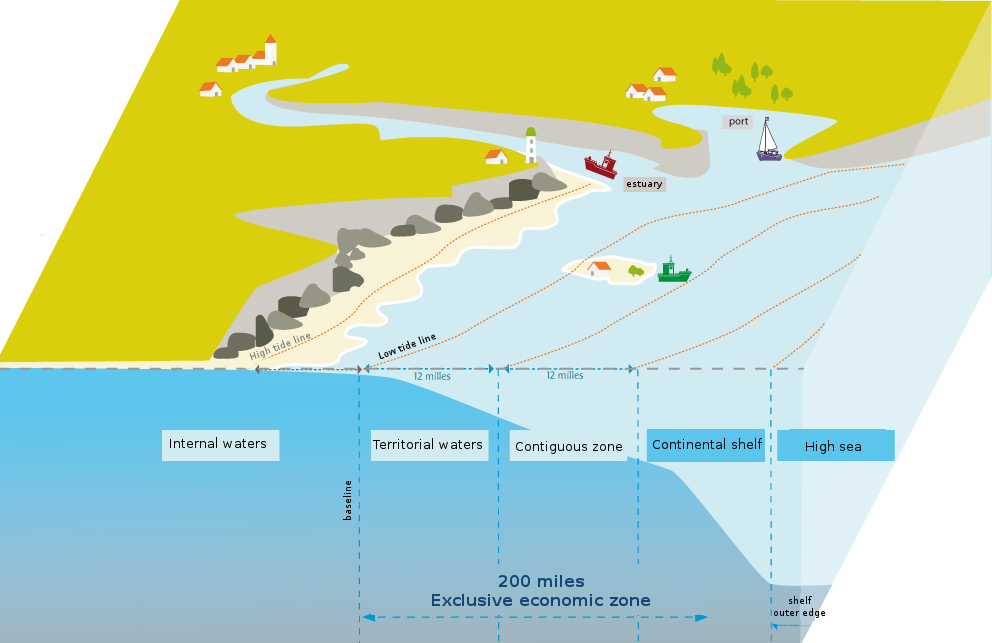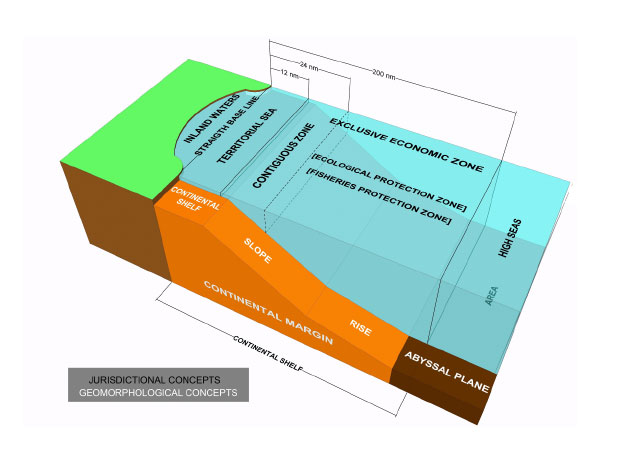Coastal states can claim five key maritime zones. Proceeding seawards from the coast they are internal waters, territorial seas, the contiguous zone, the exclusive economic zone (or, in some cases, an exclusive fishing zone) and the continental shelf. Archipelagic states may also claim archipelagic waters within their archipelagic baselines. Beyond these national zones of jurisdiction lie the international maritime zones of the high seas and the Area.
The rights of the coastal state and aliens vary in these maritime zones, and do so both spatially and functionally. Thus, the coastal state has more rights closer to shore, for example in internal waters and the territorial sea. Aliens retain considerable rights within a coastal state’s claimed maritime zones concerned with communication issues such as navigation, overflight and the laying of submarine cables and pipelines. The coastal state, in contrast, boasts significant resource related rights, particularly concerning fishing and mineral extraction from the seabed.
The limits of national claims to maritime jurisdiction are measured from the coastal state’s baselines. For national maritime zones other than internal waters and the continental shelf this is usually achieved through constructing an envelope of arcs of a distance corresponding to the breadth of the claimed zone from relevant basepoints along the coastal state’s baselines. Internal waters, in contrast, are located landward of a coastal state’s baselines. Where the continental margin extends beyond 200 nm from such baselines the limits of a coastal state’s continental shelf claim depend upon the geology and geomorphology of the margin as well as the distance from those baselines. Where national claims to maritime space overlap, maritime boundary delimitation will be required. Coastal states are also bound to give due publicity to the location of any claimed straight or archipelagic baselines, the limits of their claimed maritime zones and any delimitation lines, notably through the deposit of relevant charts or lists of coordinates with the Secretary-General of the United Nations.
When examining the maritime zones which coastal states may have or may claim, it is important to remember that while the UN Convention on the Law of the Sea has significantly extended the rights of coastal states in the waters off their coasts, these rights are accompanied by considerable responsibilities. These include obligations in relation to the conservation of living resources, the prevention, monitoring and elimination of pollution, the protection and preservation of the marine environment, enforcement of law and order at sea and marine scientific research. Such responsibilities, if seriously addressed, inevitably place considerable demands on the state’s human and financial resources.
The management implications of claiming different zones therefore need to be kept in mind by policy makers in coastal states. Stated simply, the authorities concerned need to evaluate whether the benefits that derive from claiming a particular zone outweigh the costs that will be incurred in managing the zone. This is particularly critical in the EEZ, where the coastal state has (among other responsibilities) a duty to prevent over-exploitation of the living resources of the zone.
Where the potential EEZ is large this is a major challenge demanding extensive and sophisticated infrastructure and management. Furthermore, maintaining sufficient personnel, boats and related equipment to administer the territorial sea and contiguous zone can be a very significant undertaking in itself where the coastline is of considerable length.
Nevertheless, it is clear from a survey of national claims to zones maritime jurisdiction that coastal states have embraced the opportunity to assert their rights to maritime space – in some, and perhaps many, cases regardless of their ability to fully meet the corresponding ocean management responsibilities which come with those rights.



